Aramaic Project
No. 230 to 221 - Interviews and Performances - Video List
Goto Item No. 230 | 229 | 228 | 227 | 226 | 225 | 224 | 223 | 222 | 221| Aramaic Project Number | Description | Duration | Date of recording | Place of Recording | Video |
| AP 230 | The meaning of "Qurbana" in the chant, ETHA PUS LEK. Dharmaram college. (2014) From a lecture on Christian Musicology of India at Dharmaram College. 18 July 2014. 7 PM The word Qurbana takes special meaning in the famous chant Edta Pus Lek Baslama (O Church, remain in Shanthi). This chant is a musical drama in eight stanzas and is a golden treasure in the Syriac music repertory. The leading narrative voice is that of the deceased priest. In the middle of the chant, the narrative voice changes; the congregation bids farewell to the deceased priest. The musical setting is syllabic with melismatic ornamentations at the end of selected phrases. Stylistically, the melody is similar to that of Qambel Maran. Fortunately, we have documented the Syriac and Malayalam versions of the chant in the voice of several priests, including Fr. Abel Periyappuram who created the Malayalam version that is in use currently in the Syro Malabar Church. See more information at Joseph J. Palackal. "The Survival Story of Syriac Chants among the St. Thomas Christians in South India." In Music and World Christianities. Oxford University Press (2016). https://www.oxfordhandbooks.com/view/... Resources: Fr. Probus, CMI sings Etha Pus Lek in the CD Qambel Maran: Syriac Chants from South India.Aramaic Project-4P. https://youtu.be/l4eFJi2oBKg Fr. Sankoorikkal sings "Witawangunnen". Aramaic Project-177 https://youtu.be/ZVo2cz8j7hU Fr. Abel, CMI sings "Witawangunnen." Aramaic Project -11.9. https://youtu.be/crTYiUzNbzA Fr. George Plathottam sings "Witwangunnen." Aramaic Project-140N.https://youtu.be/m0qcqmPIlVo Fr. George Plathottam sings "Etha Pus Lek." Aramaic Project-81. https://youtu.be/pOgIOLZq5yc Fr. Cyril Thayil sings "Etha Pus Lek Baslma." Aramaic Project-85 https://youtu.be/pOgIOLZq5yc A comparative study of the text and melody of Etha Pus Lek and Witawangunnen." Joseph J. Palackal. "The Survival Story of Syriac Chants among the St. Thomas Christians in South India." In Music and World Christianities. Oxford University Press (2016). https://www.oxfordhandbooks.com/view/... Joseph J. Palackal, CMINew York 21 February 2021 |
6:04 | 18 July 2014 | Dharmaram College, Bengaluru | 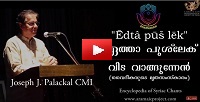 |
| AP 229 | Bar Maryam at Dharmaram College (2014) On the uniqueness of the text and melody of Bar Maryam . From a lecture at Dharmaram College, Bengaluru. 18 July 2014. This lecture took place much before the recent emotionally-laden discussions on social media regarding the origin and ownership of this chant. The song text, which may be of Middle-Eastern origin, is a common patrimony of the Chaldean Catholics as well as the Syriac Christians in India. The Chaldean Catholics continue to sing this song, albeit with a different melody and an Arabic vocal inflection ( see Chaldean Catholic Bishop Singing Bar Maryam ). Sadly, some of the Syro Malabar Catholics disowned this intangible cultural heritage even before the vernacularization of the Syriac liturgy (1962). Fortunately, the younger generation is currently warming up to the song enthusiastically to rediscover their identity. It is not clear if the melody is of Indian origin. We have one example of a Marian song in Tamil in the meter and melody of Bar Maryam (Aramaic Project-5A ). Also, we have a recorded sample of the tune with different texts from the Syriac singers from St. John Nepomucene Church at Kadavanthara, Ernakulam (Aramaic Project-51M ). This church belongs to the Archieparchy of Ernakulam-Angamaly. There is yet another sample of a popular devotional song in Malayalam that is sung to the melody of Bar Maryam (see Aramaic Project-53 ). Although the song was a common patrimony of all the Syriac Christians in Kerala, the Knanaya community among the St. Thomas Christians can be credited with preserving the tradition of singing this song at the conclusion of the wedding ceremonies in the church with a final blessing on the couple by the celebrant. The songtext, however, does not make reference to the wedding at Cana. The historical significance of the song is noteworthy. In retrospect, the Portuguese missionaries did not have to impose the burden of Nestorian heresy on the St. Thomas Christians. By singing Bar Maryam and Sagdīnan mār, the St. Thomas Christians had been reiterating in different words the correct Christology of the Ecumenical Councils of Ephesus (431) and Chalcedon (451). By continuing the tradition, the present generation of Syro Malabar Catholics can reverse the course of history and redefine the future, and add India into the international imagination of Eastern Christianity. See more on the Encyclopedia of Syriac Chants http://www.thecmsindia.org/bar-maryam... Joseph J. Palackal, CMINew York 16 February 2021 |
6:16 | 18 July 2014 | Dharmaram College, Bengaluru |  |
| AP 228 | In Tribute to Fr. Augustus Theckanath, CMI (1934-2021): A Syriac treasure. കദ് ഖായേൻ, ഹാക്ക്കെ സ്ലീവാ, ഹുത്താമ്മാ: Three Chants/Hymns are included in this video in tribute to Rev. Fr. Augustus Theckanath CMI. 1. 'Kadqaayen (Oshana / Hosana / Holy Holy)': Fr.AugustusThekkanath, CMI sings 'Kadkaen'. This is a unique segment which highlights the role of music in creating an extra ordinary experience of liturgical time during the Holy Week. Music serves as a medium for a dramatic transitioning from the solemn to the somber sense of time. It happens during the Eucharistic prayer. Halfway through the Holy, Holy, Holy, the music stops and the server rings the clapper, portending a change of time and mood. Rest of the song is sung a capella in a requiem mode. The ensuing mood continues until the Easter celebration. Luckily, Rev Fr, Augustus Theckanath CMI, Lonappan Arackal and his team has opened to us a window into the past history of the Syro Malabar liturgy, and we are grateful. 2. Hā qes slīwā (Behold the wood of the Cross): Fr. Augustus Thekkanath, CMI. sings "Hā qes slīwā". Veneration of the Cross on Good Friday, assisted by Lonappan Arackal see full interview https://youtu.be/hLzqFSfUxZk Recorded on 16 July 2013 at St. John Nepumocene Church, Konthuruthy, Ernakulam. This is a re enactment of the veneration of the Cross in Syriac, on Good Friday, before the vernacularization of the Syro Malabar liturgy in 1962. The ritual and the performance practice are the same as in the Latin liturgy. The same text is sung three times in ascending pitch registers without instrumental accompaniment, while the a Celebrant progressively uncovers the Crucifix. 3. Huthamma : Fr. Augustus Theckanath CMI sings Huthama - the final blessing in the requiem mass in Syriac. Assisted by Lonappan Arackal. Recorded on 16 July 213 at John Nepomucene Church, Konthuruthy, Ernakulam. This melody continues to be used today with the Malayalam translation of the Syriac text during requiem mass Lonappan Arackal and team in conversation with Dr. Joseph J. Palackal. See full interview https://youtu.be/hLzqFSfUxZk Recorded on 16 July 2013 at St. John Nepumocene Church, Konthuruthy, Ernakulam Please acknowledge TheCMSIndia.org and/or Joseph J. Palackal (http://www.TheCMSIndia.org/palackal.html ) when this video is used for academic or other purposes. |
8:59 | 16 July 2013 | St. John Nepumocene Church, Konthuruthy, Ernakulam | 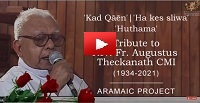 |
| AP 227 | SYRIAC: a two-centuries- long umbilical cord to the table of the Last Supper. Why should we resuscitate a dying language? From the lecture at the Syro Malabar Convention in Houston, Texas. 1- 4 August 2019. See full lecture at Aramaic Project-152. https://youtu.be/FqT_I06gVH4 It was indeed an honor for me to be invited to be a resource person at the Syro Malabar Convention 2019 at Houston, Texas. The topic I was assigned to talk about was liturgical music. I also had a mission to prepare the convention choir to sing Syriac chants during Qurbana. Therefore, it was appropriate to educate the youngsters on the need to revisit the Syriac tradition as part of their search for their unique identity. Some of the singers sang with the choir for the Qurbana at the National Shrine, on 7 September 2013 at Washington, D. C. (see Aramaic Project-66 https://youtu.be/aJnk78G_bX4 ). This was the first experience of Syriac chants for most of them. There has been a steady growth of interest in Syriac chants among the Youth. Currently, the Resurrection Hymn and the Trisagion are sung in Syriac in many Syro Malabar churches in the USA. People are getting used to the idea of a bilingual Qurbana. If this trend grows, the nature of the Syro Malabar liturgy will be different in the next fifty years. We are glad to present this part of the Houston lecture to augment the conversation on the Syriac heritage of the Syro Malabar Church. References:
New York 6 January 2021 |
19:41 | 1 to 4 August, 2019 | Syro Malabar Convention in Houston, Texas. |  |
| AP 226 | കിരീടം വാഴ്വ് : Crowning ceremony at Syro Malabar wedding. Sherin & Treesa The revival of an old tradition in the Syro Malabar Church. The crowning ceremony with bilingual singing during the wedding of Sherin Joseph and Treesa David. A grassroots level movement is gaining traction in the Syro Malabar Church to bring back the crowning ceremony as part of the wedding ritual. The younger generation of the Syro Malabar Church is taking the initiative, and their local Vicars are going along with it. The song that is part of the ceremony is in Malayalam, but the Syriac chant Bar Maryam is the tune. The performance practice is bilingual. The refrain is in Syriac and the strophes are in Malayalam. Bilingual singing, too, is a new development. It portends a positive trend for the future of the Syro Malabar liturgy and the Syriac tradition. The couple was kind enough to share their thoughts on camera. The comments are useful to researchers on Syro Malabar traditions. We are grateful to Denny Karamkunnel for sharing this video with us and doing the couple's interview. Denny was a server during the ceremony. see also Aramaic Project-171 https://youtu.be/fUlwMZh-s6c Joseph J. Palackal, CMINew York 18 January 2021 #ഷെറിൻ_ട്രീസ #Sherin_Treesa #ഷെറിൻ_ജോസഫ് #Sherin_Joseph #Treesa_David #സിറോ_മലബാർ_സഭ #Syro_Malabar_Wedding #സിറോ_Malabar_Crowning_Ceremony #Crowning_Ceremony |
5:16 | 21 Oct 2020 | St. Thomas Church, Palakuzhy, Vadakkenchery, Palakkad | 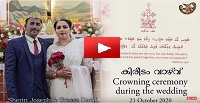 |
| AP 225 | ലാകു മാറാ . A second melody. Resurrection Hymn ഉത്ഥാന ഗീതം. Fr. G. Nellikat #FrGerogeNellikkatt #Babu_Puthumana #Benedy_Anikkad In this video, we introduce a second melody of the Resurrection Hymn, Laku Mara. It is from a recording of solemn Qurbana in Syriac by Fr. George Nellikkatt and the Cicilan choir. Babu Puthumana, an admirer of Fr. Nellikkat, made the recording. This melody is known only to a few priests and church choirs in Kerala. From Fr. Paul Kodamullil’s interview in Aramaic Project-3 (https://youtu.be/8Vxv4JRQH1o), we learn that Fr. Mathew Vadakel, a singer, professor, and scholar of the Syriac language at St. Joseph’s Seminary at Aluva, composed the melody, sometime in the early 1950s. The variety of melodies of the same chant indicates that local choirs enjoyed considerable freedom in the selection of music for the Qurbana. The melody is unique in many ways. It has two incipits and one strophe. The incipits are in the same meter and melody of the strophe. This is different from the usual performance practice in which the incipit is articulated a tempo rubato without adhering to the meter of the strophe. In the third iteration of the chant, the deacon’s exhortation completes the cadence in the melody. That, too, is unusual. In Aramaic Project-138 https://youtu.be/afyxLpf8JCk (37:00) we hear this melody in the voice of Bennedy Anikkad. We are grateful to Babu Puthumana for granting permission to post this melody on our channel and to archive it in our library. References: Aramaic Project-3 (https://youtu.be/8Vxv4JRQH1o) Aramaic Project-138 https://youtu.be/afyxLpf8JCk (37:00 Joseph J. Palackal, CMINew York 7 January 2021 |
6:07 | Track from the Music CD - Solemn Qurbana by Fr. George Nellikkatt | 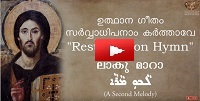 |
|
| AP 224 | The Nativity Hymn in the original language. Thesbohtha lalaha. Angels' song at the birth of Christ in its original language. 'Thesbohtha lalaha bamraume'. Glory to God in the highest. Fr. George Nellikkat. Courtesy: Babu Puthumana. Note. The Aramaic project- team would like to wish our subscribers around the world a Merry Christmas with the song that the angels sang to the shepherds, in its original language. Because Aramaic was the native language of the area at that time and the only language the illiterate shepherds would understand. From the early Christian era, important liturgical celebrations in the Syriac tradition, especially Qurbana and the Hours, started with this hymn. In Qurbana, the hymn sets the tone of the particular chronology of the salvation history. The version we hear in this video is from the Solemn Qurbana by a celebrated singer, Fr. George Nellikkat. Fr. Nellikkat was blessed with an unusual tone and a high range of voice that would remind us of the vocal quality of famous opera singers in the West. Babu Puthumana, a friend and admirer of Fr. Nellikkat, made an audio recording of the Qurbana. But for the initiative of Babu Puthumana, the outside world would not have known that such a great talent existed in Kerala. Fr. Nellikkat's vocal style is reminiscent of the pre-amplification era when singers had to reach out to a large number of people who occupied a wide space. In order to accomplish that they had to employ a high vocal register. Fr. Nellikkat's vocal style is an excellent example. The text is sung three times in ascending pitch registers. Reiterating certain texts three times used to be a characteristic of Syriac liturgy. The singing brings out the solemnity and the grandeur of the text and the joyful occasion. Sadly, the vernacular versions of this song have not captured those elements. We hope the Syriac version will become part of the liturgical experience of the Syro Malabar Catholics in the near future. Christian Musicological Society of India is grateful to Babu Puthumana for granting permission to post this on our channel. We are also grateful to Ken Rudzwick and the Maspeth Federal Savings Bank in Maspeth, New York, and Nuala Joyce of Middle Village in New York for appreciating the value of the Aramaic Project. Slamma. Merry Christmas. Joseph J. Palackal, CMI |
5:46 | Track from the Music CD - Solemn Qurbana by Fr. George Nellikkatt |
 |
|
| AP 223 | Anthem of the Mysteries Pagre damsiha. A different version.Fr George Nellikkatt Pagre(h) Damsiha. see full recording at Aramaic Project-157 The Anthem of the Mysteries with several specialties. From the solemn Qurbana by Fr. George Nellikkatt.
|
2:14 | Track from the Music CD - Solemn Qurbana by Fr. George Nellikkatt |  |
|
| AP 222 | Minor Doxology in East Syriac: Suwha Lawa/ Glory be Fr. George Nellikkatt begins the Solemn Qurbana in Syriac with the Trinitarian doxology, ending with Halleluia (three times). Source: Babu Puthumana. Choir: Cicilan Paika. See full recording at . Aramaic Project - 157. The practice of starting the solemn Qurbana with the Trinitarian doxology and Halleluia may go back to the early seventeenth century, in compliance with the outcome of the Synod of Diamper (1599). Keywords: Minor doxology. George Nellikkatt. Cicilian Paika. Babu Puthumana, Solemn qurbana in Syriac. Minor doxology, Christian Music, Syriac chants |
2:57 |
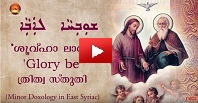 |
||
| AP 221 | A Catechism Class on St. Ephrem the Syrian. Koonammakkal Thoma Kathanar. Note: The name of St. Ephrem, the pride and glory of Syriac Christianity, is not familiar enough to the Syro Malabar Catholics. We are indeed blessed to have a class on St. Ephrem's significance by an eminent scholar of Kerala, Koonammakkal Thoma Kathanar. The theology of St. Ephrem should have been a chapter in the high school students' catechetical textbooks. This poet-saint who lived and taught and sang in the fourth century is still appealing to our era. St. Ephrem married theology to the sound and rhythm of Syriac poetry. He was very much like the rishis in India who composed Mahabharat in poetry. St. Ephrem, according to Koonammakkal Kathanar, was more prolific than the Indian rishis. Our Hindus in India have been smarter than the Christians in the matter of pedagogy of faith. Hindu stories and legends were transmitted not through formal classroom education but art and poetry. Children learned innumerable lines of poetry and mastered religious lessons through poems. St. Ephrem bequeathed a beautiful example that did not catch the attention of Syro Malabar Catholics. This video is a wake-up call. Theology is not an intellectual gymnastics but the oxygen for living, breathing lungs of faith. We hope that this video will inspire many people to rediscover St. Ephrem and tell themselves that it is all right to enjoy faith and that aesthetics and faith are complementary. "Sing to the Lord a new song" (Psalm 96:1). We are immensely grateful to Jarly Mathew and Kuriachan J. Palackal for making this videotaped conversation happen. At present, the Kathanar is suffering from ill health and we do not know when he will regain the strength to talk as he did in this video. We can only pray, be grateful to God, and enjoy what we have. Joseph J. Palackal, CMINew York 8 December 2020. (Feast of the Immaculate Conception) |
9:57 | 3 August 2014. | Recorded at Beth Aprem Nazrani Dayra, Kuravilangad, Kottayam Dt., Kerala, India. |
 |



